Login form
Ha Long Bay-The New World Natural Heritage
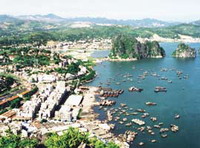
“Ha Long” is literally translated as "
This was also witnessed by many of the crews. Thus emerged the European image of the Asian dragon. Whether this appearance of a strange animal looking like a dragon resulted the name of Ha Long Bay is not known (Reference “Quang Ninh: Art and Culture” published in 2002).
There is also a local legend, which has been handed down, relating to the name Ha Long Bay, which tells the following tale:
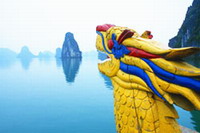
“Long ago, in the first founding days, the Viet people were attacked by foreign aggressors. The Jade Emperor sent the Mother Dragon and her band of Child Dragons to help the Viet people fight the invaders. While the enemy vessels were launching massive attacks against the mainland, the dragons descended in flocks from the sky. They spat out innumerable pearls which changed into jade stone islands the moment they touched the water. These islands linked together to form firm citadels that checked the enemy’s advance and smashed their vessels to pieces.
After the invaders were driven out, Mother Dragon and her Child Dragons did not return to Heaven but stayed on earth, right at the place where the battle occurred. The spot where the Mother Dragon landed was Ha Long, and where the Child Dragons came down was Bai Tu Long. The place where their tails violently wagged was called Long Vi, the present-day Tra Co Peninsula with its soft sandy beach stretching many kilometers.”
Geographical Location and Climate
Halong Bay is located in the Northeast of Vietnam, belonging to QuangNinh Province. It is in the coastal area stretching from 1060 56’ to 1070 37’ east longitude and 200 43’ to 210 09’ north latitude. To the west and northwest, Halong Bay stretches from Yen Hung District, and includes the large urban areas of Halong City and Cam Pha Town, as well as Van Don Island District. To the south and southeast, it is adjacent to the western Tonkin Gulf and to the west and southwest lies Cat Ba Island in the province of Hai Phong. On the world map, Ha Long Bay borders to China in the north and in the east it is adjacent to the East Sea.
In 1962, the Ministry of Culture and Information classified Halong Bay as a National Landscape Site, covering an area of 1,553 km2 with 1,969 islands. Halong Bay has been recognized twice by UNESCO as a World Heritage Area for its universal values of landscape, geology and geomorphology, respectively in 1994 and 2000, an area of 434 sq. km. including 775 islands.
The area inscribed by UNESCO (the Protected Area I - the Core Zone) is bound by Dau Go Island in the east, Ba Ham Lake in the south and Cong Tay Island in the east. The Protected Area II - the Buffer Zone is identified by the shore of the Bay running along the National Highway No. 18A, from the Gasoline Warehouse B12 in Cai Dam Precinct to the km.11 marker in Quang Hanh Precinct, Cam Pha Town. The Protected Area III - the Hinterland Zone is the sea or mainland area surrounding the buffer zone, including the area adjacent to the Cat Ba National Park of Hai Phong City.
Climate is featured humid tropical charactor, including two distinct seasons: hot, humid with much rainning in summer and cold, dry in winter. The average temperature ranges from 150 – 250C with annual average rainfall of 2,000 – 2,200mm/year. Halong Bay has a typical tidal time (tidal amplitude ranges from 3.5 – 4.0m. The degree of salt in the sea water ranges from 31 – 34.5% in the dry season and decreases in the rainy season.
Population of
Halong Bay's inhabitants are distributed as follows:
+ In the World Heritage Area: is inhabited by the fishing communities, including the 4 communes of Cua Van, Cong Tau, Vong Vieng and Ba Hang with a total of over 1,600 people. This population belongs to Hung Thang Precinct of Halong City. They live on floating houses and boats and make their livelihood by fishing and aquaculture.
+ In the environs of the World Heritage Area: the residents of Halong City, Cam Pha Town, Van Don Island District and Cat Ba Island of Haiphong City.
The system of islands and caves
Most of the islands on Ha Long Bay are limestone and were formed over 500 million years ago, and are massed in the southeast and southwest. The schist islands scattered in the southeast have an average height of between 50-200m, and have a rich covering of flora.
Within the islands of the Bay there are hundreds of beautiful caves of different shapes and sizes, including many famous names such as Thien Cung, Dau Go, Sung Sot, Tam Cung and Bo Nau. Some of them are archaeological sites retaining tangible archaeological evidence, such as Dau Go, Bo Nau, Sung Sot, Soi Nhu, Tien Long, Me Cung, and Trinh Nu caves.
Halong Bay is a home of ancient Viet people.
Soi Nhu Culture: lasted from 18,000 to 7,000 year ago, concentrated in
Cai beo Culture: (from 7,000 to 5,000 years ago) is the link between Soi Nhu Culture and Halong Cultures. Within the Halong area some relics from this culture have been found at sites such as Giap Khau and Ha Gian. Cai Beo archaeological relics have proved that our ancestors adapted to the marine environment sooner than believed, developing a great culture which converged with many of the characteristics of other Vietnamese and the Southeast Asian cultures. Cai Beo people made their livelihood not only by the traditional methods of hunting and picking, but also by marine exploitation.
Halong Culture: (from 4,500 to 3,500 years ago) is divided into 2 stages: earlier and later.
The first distinctive feature of Halong culture in the earlier stage: was the result of middle-Holocene marine transgression in the period 6,000 to 5,000 years ago. This caused the loss of a habitable environment for the Cai Beo people and resulted in most people moving to the northeast region of Hai Ninh coastal area (belonging to the present day
Halong culture in the later stage: (around 4,000 to 3,000 years ago) came about as the result of the period of maximum marine transgression This culture developed with the migration of Halong people into the plains, midlands and mountainous areas. The Halong people's habitats were relatively diverse and included caves, mountain peaks and sand bars. However, the maximum marine transgression caused inhabited areas to become islands and contact between people had to be by boat. So they became marine inhabitants and marine exploitation became the traditional livelihood. Techniques for making labor tools in this stage became more skilful. Soft pottery had become the distinctive ‘Halong Pottery’. (Ref: “Halong in the Pre-historic Time” written by Ha Huu Nga and Nguyen Van Hao, published by Halong Bay Management Department, Halong, 2002).
Halong culture in the later stage plays an important role in the ancient Viet civilization.
Halong Bay where maintained the first ancient trade port of
The book of “Dai Viet su ky toan thu” (the Complete History of Great Viet) states: “In the Spring of Ky ty year, (the second lunar month of 1149) in the 10th century, during the reign of King Ly Anh Tong, merchant ships from China, Japan and Siam called into Hai Dong for trading. They were gathered in Van Don trading port to buy and sell precious goods and present their local products.” (“Dai Viet su ky toan thu”, 5 sets, Socio and Science Publishing House, Ha Noi – 1998, corrected by Ngo Duc Tho).
The present day fishing community living on
Formation history: The
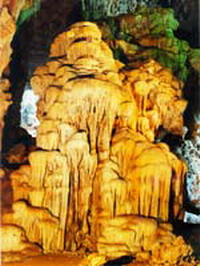 By the end of the Paleogenic and the beginning of the Neogenic periods (26 and 20 million years ago) the area had become part of a great coastal plain. This was inundated again by the sea about 2 million years ago. During the Triassic period, (240 and 195 million years ago) when most of the rest of the world was experiencing hot, dry climatic conditions, the Ha Long region had a hot and wet climate. The decayed remains of enormous forests of tree ferns were the basis of the coal deposits in the area.
By the end of the Paleogenic and the beginning of the Neogenic periods (26 and 20 million years ago) the area had become part of a great coastal plain. This was inundated again by the sea about 2 million years ago. During the Triassic period, (240 and 195 million years ago) when most of the rest of the world was experiencing hot, dry climatic conditions, the Ha Long region had a hot and wet climate. The decayed remains of enormous forests of tree ferns were the basis of the coal deposits in the area.
Karst geomorphologic value: Ha
The conical shapes of fenglin karst are like individual towers having abrupt slopes and reaching heights of between 50 - 100m. The ratio between height and width is 6:1. Conical shapes of fengcong karst can be seen in the groups of hills on Bo Hon and Dau Be islands. The karst fields were formed in different ways, such as: landslide, ceiling collapse of underground river valleys and underground caves ,and by the existence of undissolved stone layers. These karst fields were regularly flooded by the sea.
The underground karst topography is divided into 3 main types of caves:
+ Remnants of old phreatic caves such as Sung Sot, Tam Cung, Lau Dai, Thien Cung, Dau Go and Thien Long.
+ Old karstic foot caves such as Trinh Nu, Bo Nau, Tien Ong and Trong.
+ Marine notch caves such as
The karst landscape of Ha Long Bay is of international significance and of fundamental importance to the science of geomorphology. The geology of Ha Long Bay is associated with the value of its bio-diversity, archaeological culture, history and other significant values.
Bio-diversity is an important natural resource and needs to be preserved and conserved to maintain the ecological balance of the whole region. Bio-diversity is the general term used to reflect diversify and abundance in nature and includes all living things.
In Ha Long Bay it can be divided into 2 categories:
The tropical forest ecosystem:
The total number of plant species living on the rugged islands in Ha Long Bay is still not known, as many islands remain unexplored. There are probably over a thousand species of plants, the distribution of which is not uniform. Instead, several different communities (species of plants that always grow together) are found, such as: mangrove, seashore plants, those of the slopes or sheer cliffs, the summit plants and those that grow around the mouth of caves and in gullies. These plant species have adapted to live on the limestone islands in Ha Long Bay.
Researchers of IUCN in Ha Noi surveyed the area and found seven rare and unique species of flora in Ha Long. These species have adapted to live on the limestone islands in Ha Long Bay and are not found anywhere else in the world. They are Ha Long cycad, violet chirita, Ha Long fan palm, woolly chirita, Ha Long balsam, schefflera and yellow slipper orchid. According to the statistics of the
The sea -shore ecosystem: including wetland areas and sea ecosystem.
The wetland ecosystem:The wetland ecosystem in Ha Long Bay and surrounding area includes 6 sub- ecosystems:
Tidal and mangrove ecosystem: It is estimated that Ha Long Bay and its environs contain 20 species of mangrove plant. These mangrove forests of Ha Long Bay play an important role as habitats to many creatures and have a high biological capacity. They provide a home to 169 species of Polycheata, 91 species of cyanophyta, 400 species of fish, 200 species of bird, 10 species of reptile and 6 other species.
Hard bottom ecosystem - coral reefs: Coral reef ecosystem is one of the specific characteristics of Ha Long Bay, having a high biological capacity and a water cleansing ability. They are concentrated in the areas of
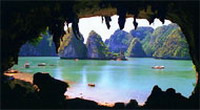 At present in Ha Long Bay, it is estimated that there are 232 listed coral species. These belong to the Coelenterate and include Anthozoa (coral class) and Hydrozoa. The coral reefs in Ha Long Bay are the home of 81 species of Gastropada, 130 species of Bivalvia, 55 species of Polycheata and 57 species of Brachyura.
At present in Ha Long Bay, it is estimated that there are 232 listed coral species. These belong to the Coelenterate and include Anthozoa (coral class) and Hydrozoa. The coral reefs in Ha Long Bay are the home of 81 species of Gastropada, 130 species of Bivalvia, 55 species of Polycheata and 57 species of Brachyura.
Cave and “ Tung”, “Ang” (Lagoon) ecosystem: This is a special ecosystem. "Ang" refers to the reservoirs, lying among islands; “Tung” is the closed lakes and their smooth waters. These favorable conditions create this special ecosystem, which is such a beautiful feature of the Bay. For example: Tung Ngon is home to 65 species of coral, 18 species of sea- weed, 40 species of benthos and 4 rare species listed in the “Red Book of Viet Nam”. Numerous caves and grottoes have been restored for the purpose of conservation and tourism development on Ha Long Bay, though some still keep their primitive beauty.
Soft bottom ecosystem: This is a sea-grass ecosystem. It is comprised of only 5 species of sea-grass, however it is the habitat for many other species. It also has the advantages of preventing the creation of waves and cleaning the water environment by absorbing organic waste. It is estimated that, at present, the number of species living in sea grass ecosystem includes 141 species of sea-weeds, 3 species of Polycheata (sand worms), 29 species of mollusc and 9 species of Grustacea.
Tidal flats without mangrove forest: are found in the low tidal areas. Molluscs (Shells) and sandworms (Bivalve) are typical species living off the tidal flats and have a very high nutritional value, examples: sea cucumber, Arca granosa and Meretrix. Almost all creature resources of the tidal flats are being over exploited.
Aquatic ecosystem: This marine ecosystem includes phytoplankton, zooplankton, zoo-benthos and nekton.
Phytoplankton: These are the small animals drifting about in the water, they can autotrophy through the process of photosynthesis. They contribute to the dissolution of organic matter and thus help against water pollution. According to the results of site surveys, there are 185 Phytoplankton species in Ha Long Bay.
Zooplankton: These too are small animals drifting about in the water, they are the second link in the nutrient chain (next to the phytoplankton). The distribution of Zooplankton is dependent on the water layers and time. It is estimated that there are 140 Zooplankton species in the Ha Long - Cat Ba area.
Zoo-benthos: These creatures live on the bottom of the sea and have very high nutritional value. Surveys showed that there are 500 zoo-benthos species in Ha Long area, of which 300 are mollusc species, 200 Polycheata species (sand worms) and 13 Echinodermata species.
Nekton: These animals can swim in the water by themselves and migrate to look for food. They breed or shelter in winter. It is estimated that there are 326 nekton species in the Bay.
Species multiply: In 2002 a survey on assessing and auditing Ha Long Bay’s bio-diversity was conducted by management authorities and researchers. They surveyed 9 areas in Zone 1 of the World Heritage: Dau Be Island,
Current figures indicate there are a total of 1,847 species and 30 cave-grotto species groups in Ha Long Bay. Almost all the typical ecosystems found in a tropical sea area converge in Ha Long Bay, for example: coral reefs, sea-grass, mangrove forests, and "Tung" and "Ang". Ha Long Bay is home to 189 species of fish, 500 species of benthos, 355 species of plankton, 140 species of seaweed, 7 species of sea-grass and 34 species of mangrove (according to data provided by the ‘National Conference on Ha Long Bay Bio-diversity’. [December, 2003, Ha Long City]
Diversity of Gene: In April 2003, a survey of three areas of Ha Long Bay, [Dau Be, Hang Trai and Cong Do] conducted by
The first time:On 21st December, 1991, The Government of Vietnam permitted the setting up a of file on Ha Long Bay to be submitted to UNESCO for recognition of Ha Long Bay as a World Heritage Site. During the two year period 1991 to 1993, UNESCO nominated many expert delegations to come to Quang Ninh to survey, research, guide and review the ongoing file. Ha
On 17th December, 1994, the World Heritage Committee officially recognized Ha Long Bay as a World Natural Heritage Area at its 18th session in
The second time:At the request of Ha Long Bay Management Department and IUCN, in September 1998, Prof. Tony Waltham, the top expert on Geology of Trent University,
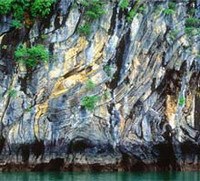 In July 1999, the file was completed and sent to the World Heritage Center’s Office in Paris. In December 1999, at the 23rd Congress of UNESCO held in Marakesh, Morocco, UNESCO officially considered the file. In March 2000 Professor Ellery Hamilton Smith, a member of IUCN was delegated to come to Ha Long to check the validity of the file and its geological value and to evaluate the management situation and make recommendations. In July 2000, at its mid-year meeting, the World Heritage Center, Paris, officially proposed that the World Heritage Committee recognize Ha Long Bay as a World Natural Heritage Site for its universal values of geology and geomorphology.
In July 1999, the file was completed and sent to the World Heritage Center’s Office in Paris. In December 1999, at the 23rd Congress of UNESCO held in Marakesh, Morocco, UNESCO officially considered the file. In March 2000 Professor Ellery Hamilton Smith, a member of IUCN was delegated to come to Ha Long to check the validity of the file and its geological value and to evaluate the management situation and make recommendations. In July 2000, at its mid-year meeting, the World Heritage Center, Paris, officially proposed that the World Heritage Committee recognize Ha Long Bay as a World Natural Heritage Site for its universal values of geology and geomorphology.
On 2nd December, 2000, at the 24th session of the World Heritage Committee held in Cairns, Queensland, Australia, the World Heritage Committee unanimously decided to recognize the universal geological value of Ha Long Bay for the second time according to criteria (i) of the International Convention on the Protection of the World National and Cultural Heritage.
Source: www.halongbay.net.vn

